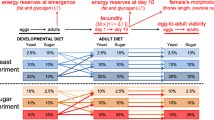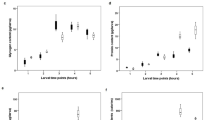Abstract
Experimental adaptation of Drosophila melanogaster to nutrient-deficient starch-based (S) medium resulted in lifespan shortening, increased early-life fecundity, accelerated reproductive aging, and sexually dimorphic survival curves. The direction of all these evolutionary changes coincides with the direction of phenotypic plasticity observed in non-adapted flies cultured on S medium. High adult mortality rate caused by unfavorable growth medium apparently was the main factor of selection during the evolutionary experiment. The results are partially compatible with Williams’ hypothesis, which states that increased mortality rate should result in relaxed selection against mutations that decrease fitness late in life, and thus promote the evolution of shorter lifespan and earlier reproduction. However, our results do not confirm Williams’ prediction that the sex with higher mortality rate should undergo more rapid aging: lifespan shortening by S medium is more pronounced in naive males than females, but it was female lifespan that decreased more in the course of adaptation. These data, as well as the results of testing of F1 hybrids between adapted and control lineages, are compatible with the idea that the genetic basis of longevity is different in the two sexes, and that evolutionary response to increased mortality rate depends on the degree to which the mortality is selective. Selective mortality can result in the development of longer (rather than shorter) lifespan in the course of evolution. The results also imply that antagonistic pleiotropy of alleles, which increase early-life fecundity at the cost of accelerated aging, played an important role in the evolutionary changes of females in the experimental lineage, while accumulation of deleterious mutations with late-life effects due to drift was more important in the evolution of male traits.
Similar content being viewed by others
References
Kawecki, T. J., Lenski, R. E., Ebert, D., Hollis, B., Olivieri, I., and Whitlock, M. C. (2012) Experimental evolution, Trends Ecol. Evol., 27, 547–560.
Skulachev, V. P. (1999) Phenoptosis: programmed death of an organism, Biochemistry (Moscow), 64, 1418–1426.
Weismann, A. (1889) Essays upon Heredity and Kindred Biological Problems, Clarendon, Oxford.
Longo, V. D., Mitteldorf, J., and Skulachev, V. P. (2005) Programmed and altruistic ageing, Nat. Rev. Genet., 11, 866–872.
Markov, A. V. (2012) Can kin selection facilitate the evolution of the genetic program of senescence? Biochemistry (Moscow), 77, 733–741.
Woods, R. J., Barrick, J. E., Cooper, T. F., Shrestha, U., Kauth, M. R., and Lenski, R. E. (2011) Second-order selection for evolvability in a large Escherichia coli population, Science, 331, 1433–1436.
Hamilton, W. D. (1966) The moulding of senescence by natural selection, J. Theor. Biol., 12, 12–45.
Rose, M. (1991) Evolutionary Biology of Aging, Oxford University Press, Oxford.
Williams, G. C. (1957) Pleiotropy, natural selection, and the evolution of senescence, Evolution, 11, 398–411.
Medawar, P. B. (1952) An Unsolved Problem of Biology, HK Lewis, London.
Haldane, J. B. S. (1941) New Paths in Genetics, Allen and Unwin, London, UK.
Wattiaux, J. M. (1968) Cumulative parental age effects in Drosophila subobscura, Evolution, 22, 406–421.
Rose, M. R., and Charlesworth, B. (1981) Genetics of life history in Drosophila melanogaster. II. Exploratory selection experiments, Genetics, 97, 187–196.
Rose, M. R. (1984) Laboratory evolution of postponed senescence in Drosophila melanogaster, Evolution, 38, 1004–1010.
Luckinbill, L. S., Arking, R., Clare, M. J., Cirocco, W. C., and Buck, S. A. (1984) Selection for delayed senescence in Drosophila melanogaster, Evolution, 38, 996–1003.
Mueller, L. D. (1987) Evolution of accelerated senescence in laboratory populations of Drosophila, Proc. Natl. Acad. Sci. USA, 84, 1974–1977.
Partridge, L., and Fowler, K. (1992) Direct and correlated responses to selection on age at reproduction in Drosophila melanogaster, Evolution, 46, 76–91.
Partridge, L., Prowse, N., and Pignatelli, P. (1999) Another set of responses and correlated responses to selection on age at reproduction in Drosophila melanogaster, Proc. R Soc. Lond. B Biol. Sci., 266, 255–261.
Travers, L. M., Garcia-Gonzalez, F., and Simmons, L. W. (2015) Live fast die young life history in females: evolutionary trade-off between early life mating and lifespan in female Drosophila melanogaster, Sci. Rep., 5, 15469.
Stearns, S. C., Ackermann, M., Doebeli, M., and Kaiser, M. (2000) Experimental evolution of aging, growth, and reproduction in fruitflies, Proc. Natl. Acad. Sci. USA, 97, 3309–3313.
Kirkwood, T. B. (1977) Evolution of ageing, Nature, 270, 301–304.
Kirkwood, T. B., and Rose, M. R. (1991) Evolution of senescence: late survival sacrificed for reproduction, Philos. Trans. R Soc. Lond. Ser. B Biol. Sci., 332, 15–24.
Sgro, C. M., and Partridge, L. (1999) A delayed wave of death from reproduction in Drosophila, Science, 286, 2521–2524.
Linnen, C., Tatar, M., and Promislow, D. (2001) Cultural artifacts: a comparison of senescence in natural, laboratory-adapted and artificially selected lines of Drosophila melanogaster, Evol. Ecol. Res., 3, 877–888.
Abrams, P. A. (1993) Does increased mortality favor the evolution of more rapid senescence? Evolution, 47, 877–887.
Reznick, D. N., Bryant, M. J., Roff, D., Ghalambor, C. K., and Ghalambor, D. E. (2004) Effect of extrinsic mortality on the evolution of senescence in guppies, Nature, 431, 1095–1099.
Williams, P. D., Day, T., Fletcher, Q., and Rowe, L. (2006) The shaping of senescence in the wild, Trends Ecol. Evol., 21, 458–463.
Chen, H., and Maklakov, A. A. (2012) Longer life span evolves under high rates of condition-dependent mortality, Curr. Biol., 22, 2140–2143.
Reznick, D. N., Shaw, F. H., Rodd, F. H., and Shaw, R. G. (1997) Evaluation of the rate of evolution in natural populations of guppies (Poecilia reticulata), Science, 275, 1934–1937.
Williams, P. D., and Day, T. (2003) Antagonistic pleiotropy, mortality source interactions, and the evolutionary theory of senescence, Evolution, 57, 1478–1488.
Markov, A. V., Ivnitsky, S. B., Kornilova, M. B., Naimark, E. B., Shirokova, N. G., and Perfilieva, K. S. (2015) Maternal effect obscures adaptation to adverse environments and hinders divergence in Drosophila melanogaster, Zh. Obshch. Biol., 76, 429–437.
Markov, A. V., Naimark, E. B., and Yakovleva, E. U. (2016) Temporal scaling of age-dependent mortality: dynamics of aging in Caenorhabditis elegans is easy to speed up or slow down, but its overall trajectory is stable (on the paper by Stroustrup et al. entitled “The temporal scaling of Caenorhabditis elegans ageing” published in Nature, 530, 103–107 (2016)), Biochemistry (Moscow), 81, 1145–1152.
Mousseau, T. A., Uller, T., Wapstra, E., and Badyaev, A. V. (2009) Evolution of maternal effects: past and present, Philos. Trans. R Soc. B, 364, 1035–1038.
Francis, A. (2008) Business Mathematics and Statistics, 6th Edn., Cengage Learning EMEA, UK.
Tukey, J. (1949) Comparing individual means in the analysis of variance, Biometrics, 5, 99–114.
R Core Team (2015) R: A Language and Environment for Statistical Computing, R Foundation for Statistical Computing, Vienna, Austria.
Chen, H., and Maklakov, A. A. (2014) Condition dependence of male mortality drives the evolution of sex differences in longevity, Curr. Biol., 24, 2423–2427.
Waddington, C. H. (1953) Genetic assimilation of acquired characters, Evolution, 7, 118–126.
Stroustrup, N., Anthony, W. E., Nash, Z. M., Gowda, V., Gomez, A., Lopez-Moyado, I. F., Apfeld, J., and Fontana, W. (2016) The temporal scaling of Caenorhabditis elegans ageing, Nature, 530, 103–107.
Nuzhdin, S. V., Pasyukova, E. G., Dilda, C. L., Zeng, Z. B., and Mackay, T. F. (1997) Sex-specific quantitative trait loci affecting longevity in Drosophila melanogaster, Proc. Natl. Acad. Sci. USA, 94, 9734–9739.
Lehtovaara, A., Schielzeth, H., Flis, I., and Friberg, U. (2013) Heritability of life span is largely sex limited in Drosophila, Am. Nat., 182, 653–665.
Clarke, J. M., and Smith, M. J. (1955) The genetics and cytology of Drosophila subobscura, XI. Hybrid vigor and longevity, J. Genet., 53, 172–180.
Rose, M. R., Drapeau, M. D., Yazdi, P. G., Shah, K. H., Moise, D. B., Thakar, R. R., Rauser, C. L., and Mueller, L. D. (2002) Evolution of late-life mortality in Drosophila melanogaster, Evolution, 56, 1982–1991.
Gems, D., Sutton, A. J., Sundermeyer, M. L., Albert, P. S., King, K. V., Edgley, M. L., Larsen, P. L., and Riddle, D. L. (1998) Two pleiotropic classes of daf-2 mutation affect larval arrest, adult behavior, reproduction and longevity in Caenorhabditis elegans, Genetics, 150, 129–155.
Holzenberger, M., Dupont, J., Ducos, B., Leneuve, P., Geloen, A., Even, P. C., Cervera, P., and Le Bouc, Y. (2003) IGF-1 receptor regulates lifespan and resistance to oxidative stress in mice, Nature, 421, 182–187.
Toivonen, J. M., and Partridge, L. (2009) Endocrine regulation of ageing and reproduction in Drosophila, Mol. Cell. Endocrinol., 299, 39–50.
Crispo, E. (2007) The Baldwin effect and genetic assimilation: revisiting two mechanisms of evolutionary change mediated by phenotypic plasticity, Evolution, 61, 2469–2479.
Iordanskij, N. N. (2009) Phenotypic plasticity and evolution of organisms, Zh. Obshch. Biol., 70, 3–9.
Fitzpatrick, B. M. (2012) Underappreciated consequences of phenotypic plasticity for ecological speciation, Int. J. Ecol., http://dx.doi.org/10.1155/2012/256017.
Ghalambor, C. K., Hoke, K. L., Ruell, E. W., Fischer, E. K., Reznick, D. N., and Hughes, K. A. (2015) Non-adaptive plasticity potentiates rapid adaptive evolution of gene expression in nature, Nature, 525, 372–375.
Grether, G. F. (2005) Environmental change, phenotypic plasticity, and genetic compensation, Am. Nat., 166, 115–123.
Partridge, L., Alic, N., Bjedov, I., and Piper, M. D. W. (2011) Ageing in Drosophila: The role of the insulin/Igf and TOR signaling network, Exp. Gerontol., 46, 376–381.
Pasco, M. Y., and Leopold, P. (2012) High sugar-induced insulin resistance in Drosophila relies on the lipocalin Neural Lazarillo, PLoS One, 7, e36583.
Rauser, C. L., Tierney, J. J., Gunion, S. M., Covarrubias, G. M., Mueller, L. D., and Rose, M. R. (2006) Evolution of late-life fecundity in Drosophila melanogaster, J. Evol. Biol., 19, 289–301.
Author information
Authors and Affiliations
Corresponding author
Additional information
Original Russian Text © E. U. Yakovleva, E. B. Naimark, A. V. Markov, 2016, published in Biokhimiya, 2016, Vol. 81, No. 12, pp. 1721–1739.
Rights and permissions
About this article
Cite this article
Yakovleva, E.U., Naimark, E.B. & Markov, A.V. Adaptation of Drosophila melanogaster to unfavorable growth medium affects lifespan and age-related fecundity. Biochemistry Moscow 81, 1445–1460 (2016). https://doi.org/10.1134/S0006297916120063
Received:
Published:
Issue Date:
DOI: https://doi.org/10.1134/S0006297916120063




